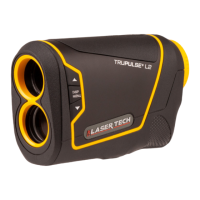Laser Technology, Inc. TruPulse L2 User’s Manual 1st Edition
Section 1 - Introducing the LTI TruPulse L2
Page 4
Copyright© 2023, Laser Technology, Inc. All rights reserved.
Understanding How the TruPulse L2 Works
The TruPulse L2 consists of a laser range sensor, an integrated accelerometer tilt sensor, and a digital processor.
The TruPulse L2 has four buttons that access the unit's internal firmware, which controls the integrated sensors.
PLCD Display: Automatic Brightness Display
A Polymer Dispersed Liquid Crystal (PLCD) is mounted within the optical system and when activated, displays a reticle
for targeting and the display indicators.
The TruPulse L2 is equipped with a built-in light sensor that reads ambient light. The internal software adjusts the
red brightness intensity based on the measured light reading. This allows for the right amount of red brightness for
the surrounding conditions.
NOTE The brightness display is 100% automatic no need to adjust brightness manually.
Laser Range Sensor
The laser range sensor emits invisible, eye safe, infrared energy pulses. The TruPulse L2 determines distance
by measuring the time it takes for each pulse to travel from the rangefinder to the target, and back. The laser
indicator is displayed whenever the laser is being transmitted. The laser may be active for a maximum of 10 seconds.
Once the target is acquired or the laser has timed out, you can release the FIRE button. The TruPulse L2 has a
broad spectrum of sensitivity and can work with both reflective and non-reflective targets.
TruTargeting
The TruPulse automatically provides the best accuracy and acquisition distance to a given target.
Maximum measurement distance varies with target quality and environmental conditions.
When shooting to a target, the maximum measurement distance is approximately 2,195 m (7,200 ft) to
reflective targets.
When selecting a target, you should consider the following:
• Color: The brighter the color, the longer the range.
• Finish: Shiny finishes provide longer range than dull finishes.
• Angle: Shooting perpendicular to a target provides better range than
shooting to a target at a sharp angle.
• Lighting Conditions: Overcast skies will increase the unit's maximum range,
and sunny skies will decrease the unit's maximum range.
Target quality has an effect on the precision of measurements:
• A high quality target will result in a measurement that includes one decimal place (tenths).
• A low quality target will result in a Measurement that is a whole number.
Tilt Sensor
The integrated tilt sensor measures vertical angles that the TruPulse L2 uses to calculate height and elevation,
and also to determine slope-reduced horizontal distances. The instrument is held level at 0°, and is rotated up
through +90° and down through -90°.
Examples:
• 120 meters (feet) indicates a measurement was made to a low-quality target.
• Accuracy: ±1 m (±3 ft).
• 120.0 meters (feet) indicates a measurement was made to a high-quality target.
• Feet are shown in half-unit increments (.0 or 0.5).
• Meters and Yards are shown in tenth-unit increments (.0 - 0.9).
• Accuracy: ±0.5 m (±1.6 ft).

